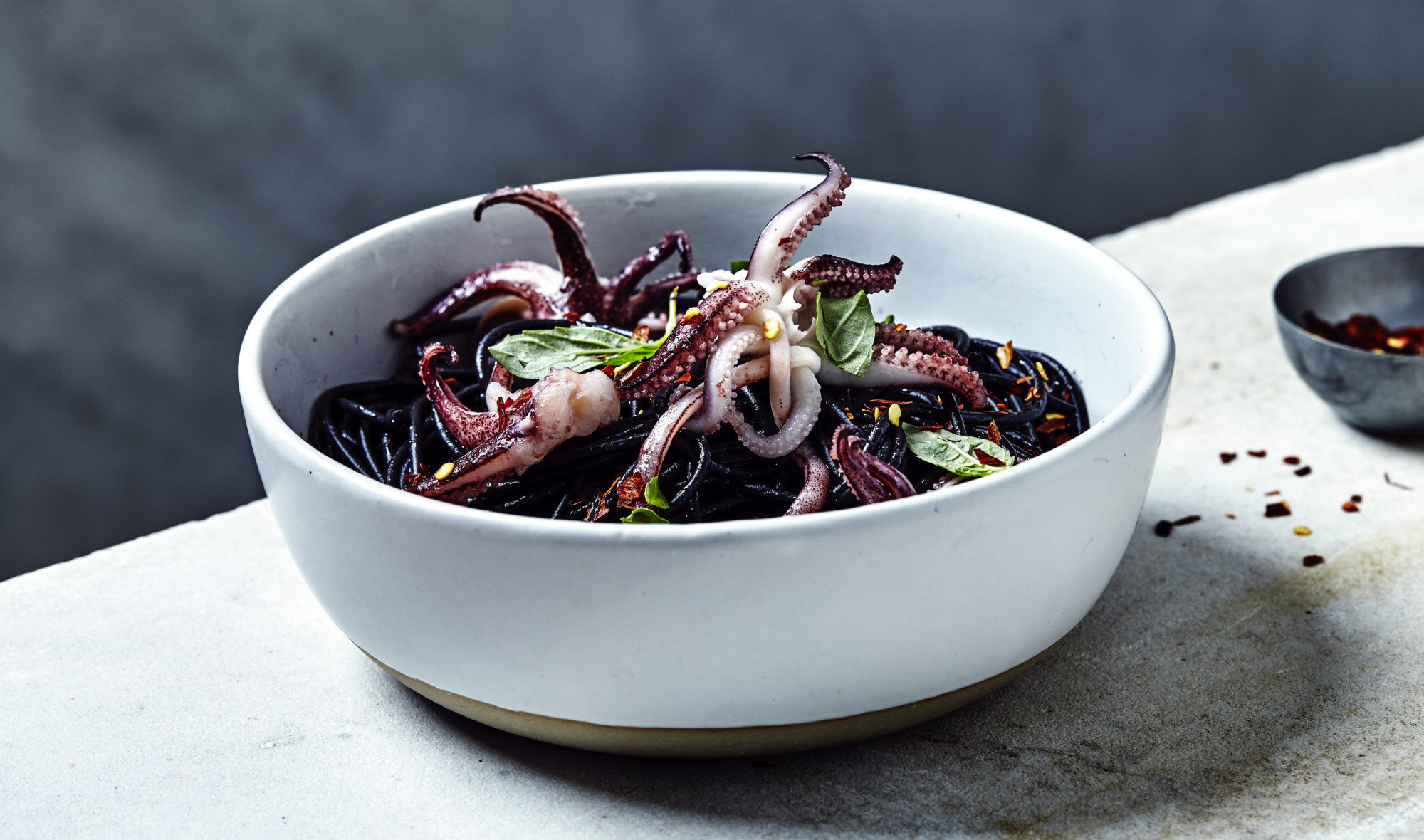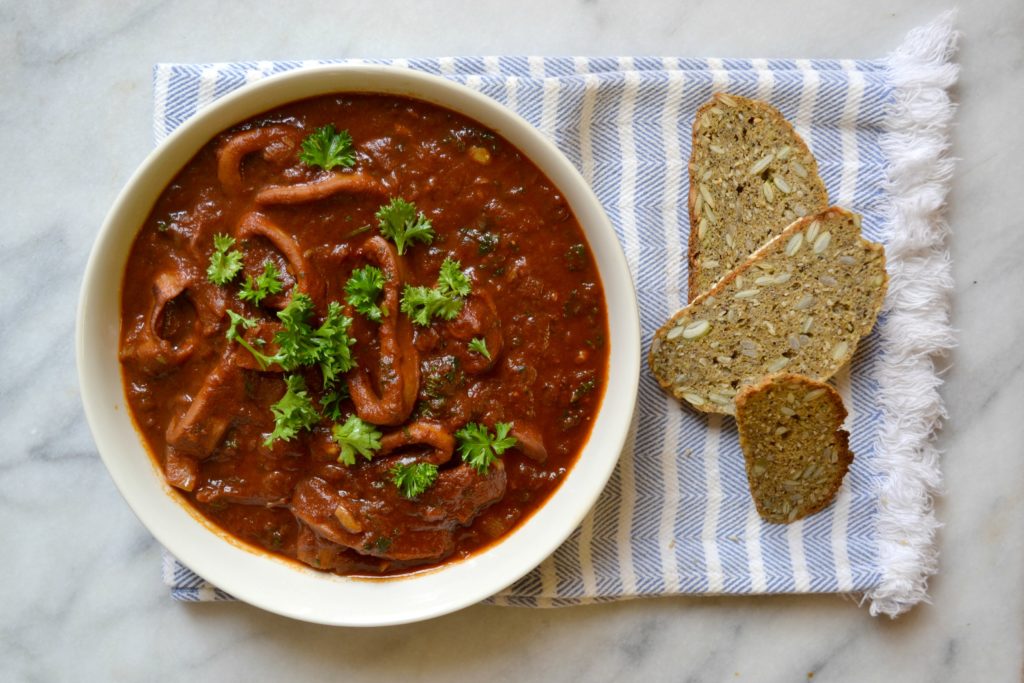
NEW! Lowest Monthly Payment Plan Ever—Master Health Coaching Certification. This week only.

NEW! Lowest Monthly Payment Plan Ever—Level 2 Master Health Coaching Certification.

Squid is a type of seafood with tender white, slightly sweet tasting flesh. It is a protein-dense food that is a good source of zinc, selenium, and B12. Squid is commonly found battered or stuffed, but is likely most nutritious when prepared simply, either grilled or sautéed. Squid cooks fast – overcook it and you’re in for a terrible rubbery adventure.
The squid is a member of the cephalopod family. Cephalopods are organisms whose feet grow directly out of their heads.
Aside from having this interesting physical configuration, squids are also a delicious seafood.
There are many varieties of edible squid, and they are found in both saltwater and freshwater habitats, although the North Atlantic Ocean hosts the densest population.
And, despite internet controversy, according to expert sources we consulted for this article (Fish Mongers at De La Mer and Hooked in Toronto, Ontario), there is no difference between squid and calamari.
Squids have a tubular, slightly tapered, oblong body with little fins at the tip. Attached to this are eight shorter arms and two longer tentacles, all textured with tiny little suckers.
The flesh of a prepared and cooked squid is opaque and white with a mild, slightly sweet flavor. When cooked properly, squid should be soft and tender. Generally, smaller, younger squid are more tender than larger, older squid.
3 oz of raw squid (inedible parts removed) has 78 calories, 13.3g protein, 2.6g of carbohydrates, 1.2g of fat, and no fiber or sugar. Squid is a good source of zinc, selenium, and B12.
Squid can either be found frozen or fresh, and is found in most larger grocery stores or fish markets.
Frozen squid is typically already cleaned and prepared and may be sold with its body intact, in whole tubes, or chopped into rings. It may be sold with or without tentacle portions. If preparing squid from frozen, thaw squid out in a colander under cold, running water.
Fresh squid can be found either whole or prepared. When shopping for whole squid, look for specimens with moist flesh that is purple to white in color, and that smells clean and sweet. Avoid squids that are brown or foul-smelling.
Squid is also available for purchase battered or stuffed. In this case, read the ingredients! These prepared versions may contain high amounts of trans fats, flavoring agents, and/or preservatives.
Fresh squid can be kept in the fridge in an airtight container for up to two days. After two days, squid should either be cooked and consumed or frozen for later use.
Once cooked, squid will keep in the fridge in a sealed container for two to three days.
Both raw and cooked squid freezes well, and can be kept frozen for up to three months.
Most of the squid is edible: the body, the arms, the tentacles, and even the ink. Only the beak (aka. squid mouth) and the gladius (an internal shell-like body part) are inedible.
If you happen to get a whole, unprepared squid, here is how to get it ready for your belly:
First, detach the body from the limbs. They should come apart easily.
Next, prepare the limbs by cutting off the head just below the eyes. Discard the head and the associated guts attached to it, and reserve the portion with the limbs attached. Pick up the portion with the limbs and “pop” out the hard, ball-shaped beak of the squid, and discard that as well.
Then, reach inside the hollow body, and pull out the hard gladius, which is not unlike the blade of a small, transparent plastic sword. Discard the gladius.
Now you can skin the body of the squid using your fingers or a small knife. It should come off fairly easily if you are careful. Discard the skin.
The squid is now ready to be fried, grilled, or marinated. You can leave the parts as they are, cut the body into rings, or score it with a knife in a cross-hatch pattern.
Squid takes only a few minutes to cook. About two minutes over high heat should be enough. The squid body will become opaque and the tentacles will curl slightly when it is ready. Overcooked squid will turn tough and rubbery – this can happen fast, so watch it closely!

There are two ways to cook squid: Fast and light, or low and slow. Anything in between will yield an unpalatable, rubbery mess, but the extremes yield a tender, delicious treat. This stew takes the latter approach and tenderizes the meat with a low and slow approach. This hearty stew can be served as a sauce over rice, pasta, or veggies, or as a stew served alongside a slice or two of crusty, artisanal bread.
Prep Time: 5 minutes Cook Time: 80 minutes Yield: 6 to 8 servings
Add bacon to a large pot over medium-high heat. Cook until lightly crispy, about 3-5 minutes. Add olive oil, fennel seeds, garlic, onion, chopped fennel, salt, and spices, and cook until vegetables have softened, about 5-7 minutes.
Add the wine, and turn the heat up to high. Cook, stirring frequently, until wine has reduced by half.
Add the squid and the crushed tomatoes, and stir to combine. Reduce the heat, cover the pot, and allow to simmer for about an hour. After an hour, sample a piece of calamari; It should be soft, not rubbery. If it is still chewy or tough, simmer for another 15 minutes, covered.
Once the squid is tender, add the parsley and the pepper, stir, and serve.
May be served as a pasta sauce over pasta, rice, or vegetables, or as a stew with a side of crusty bread. Enjoy!
Precision Nutrition’s Encyclopedia of Food expands every single month as we highlight new foods and showcase beautiful food photography. If you’d like to stay up to date, simply click this link. From there, we’ll send you a FREE copy of our recipe book. We’ll also let you know when new and delicious foods are added to the site.
Squid is a type of seafood with tender white, slightly sweet tasting flesh. It is a protein-dense food that is a good source of zinc, selenium, and B12. Squid is commonly found battered or stuffed, but is likely most nutritious when prepared simply, either grilled or sautéed. Squid cooks fast – overcook it and you’re in for a terrible rubbery adventure.